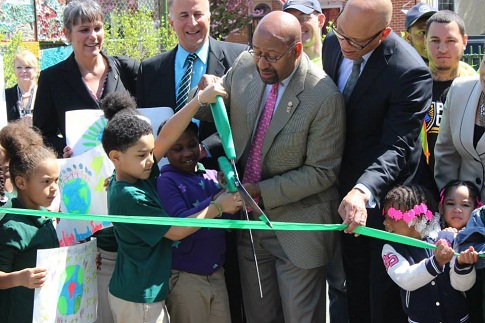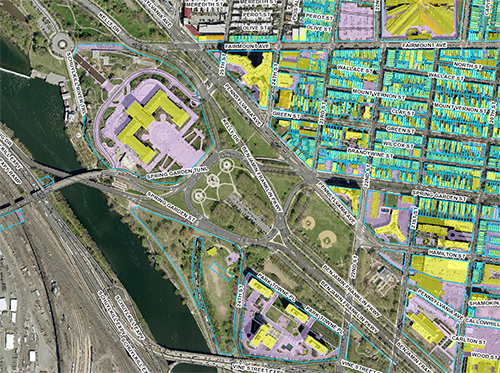No? Come out to Main and Lock streets in Manayunk tonight at 6 p.m. and get the inside scoop along with a free scoop of ice cream.

Cyclists stop to ask about the new Waterways artwork in Manayunk. Credit: Philadelphia Water.
While we were working with Mural Arts to install artist Eurhi Jones’ Waterways, a 10-block string of colorful steppingstones in Manayunk, our public engagement team took the time to do an informal survey of people passing through the neighborhood.
During the first two weeks of May, we spoke with 113 people at Pretzel Park, on Main Street, and at Venice Island–all places now featuring the temporary street art of Waterways.
What we found reinforces our motivation for creating Waterways in the first place, and shows a definitive gap between what people want for the Schuylkill River and what they know about the work being done to make that desire a reality.
First, we asked people if they knew about the Philadelphia Water improvements that debuted at Venice Island in October 2014. Those improvements include a massive stormwater basin that keeps as much as 4 million gallons of untreated water from entering the Schuylkill as well as Philadelphia Parks and Recreation’s Venice Island Performing Arts and Recreation Center.
Of the 113 people we spoke to, just 11 said they knew about Philadelphia Water’s work at Venice Island.
That lack of knowledge is precisely why we wanted to use art as a means of highlighting infrastructure. The work we do can be a little hard to wrap your head around if you aren’t an engineer or environmental scientist. Waterways uses compelling imagery to draw people toward the somewhat hidden grounds of Venice Island, where signs help to explain what the infrastructure–much of it shielded from view beneath the ground–is doing to make the Schuylkill a cleaner, healthier river.
And, if our informal little survey tells us anything, it’s that people really do care about making our rivers healthier places where both people and wildlife can thrive. When asked whether they support improving the health of our waterways, all 113 people said yes. People were also unanimously positive when asked if they think waterways can be incorporated into our city’s public spaces for recreation.
So, people want cleaner rivers and they want them to be a part of our recreational lives: places where we can fish, hike, go boating and more. Yet very few people seem to know what a huge public effort has been made in the pursuit of those goals.
Tonight, people will have a chance to learn about what Philadelphia Water is doing for the Schuylkill as we unveil Waterways at a 6 p.m. ceremony and ice cream party (the treats are on us). Join us at Main and Lock streets, tour the artwork with Eurhi Jones, and educate yourself about how we’re working to make the Schuylkill the river we all want it to be.
If you can’t make it tonight, find us on Venice Island this Saturday during the PLAY Manayunk festival, and help spread the word about Philadelphia Water and Waterways to your neighbors. After all, it’s your informed support that makes fighting for the health of our rivers possible.
Follow along on social media: @PhillyH20 on Twitter and Instagram and Facebook.com/PhillyH2O and use #phillywaterart to see what is being posted about Waterways!



